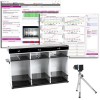Authors
I LŽna, M Mantegazza
Lab
UniversitŽ C™te dÕAzur, 660 Route des Lucioles, 06560, Valbonne - Sophia Antipolis, France
Journal
Scientific Reports
Abstract
Mutations of the SCN2A gene, encoding the voltage gated sodium channel NaV1.2, have been associated to a wide spectrum of epileptic disorders ranging from benign familial neonatal-infantile seizures to early onset epileptic encephalopathies such as Ohtahara syndrome. These phenotypes may be caused by either gain-of-function or loss-of-function mutations. More recently, loss-of-function SCN2A mutations have also been identified in patients with autism spectrum disorder (ASD) without overt epileptic phenotypes. Heterozygous Scn2a knock-out mice (Scn2a+/_) may be a model of this phenotype. Because ASD develops in childhood, we performed a detailed behavioral characterization of Scn2a+/_ mice comparing the juvenile/adolescent period of development and adulthood. We used tasks relevant to ASD and the different comorbidities frequently found in this disorder, such as anxiety or intellectual disability. Our data demonstrate that young Scn2a+/_ mice display autistic-like phenotype associated to impaired memory and reduced reactivity to stressful stimuli. Interestingly, these dysfunctions are attenuated with age since adult mice show only communicative deficits. Considering the clinical data available on patients with loss-of-function SCN2A mutations, our results indicate that Scn2a+/_ mice constitute an ASD model with construct and face validity during the juvenile/adolescent period of development. However, more information about the clinical features of adult carriers of SCN2A mutations is needed to evaluate comparatively the phenotype of adult Scn2a+/_ mice.
BIOSEB Instruments Used:
Tail Suspension Test - Wireless (BIO-TST5),Aron Test or Four Plates Test (LE830),Rotarod (BX-ROD)

 Douleur - Allodynie/Hyperalgésie Thermique
Douleur - Allodynie/Hyperalgésie Thermique Douleur - Spontanée - Déficit de Posture
Douleur - Spontanée - Déficit de Posture Douleur - Allodynie/Hyperalgésie Mécanique
Douleur - Allodynie/Hyperalgésie Mécanique Apprentissage/Mémoire - Attention - Addiction
Apprentissage/Mémoire - Attention - Addiction Physiologie & Recherche Respiratoire
Physiologie & Recherche Respiratoire
 Douleur
Douleur Système Nerveux Central (SNC)
Système Nerveux Central (SNC)  Neurodégénérescence
Neurodégénérescence Système sensoriel
Système sensoriel Système moteur
Système moteur Troubles de l'humeur
Troubles de l'humeur Autres pathologies
Autres pathologies Système musculaire
Système musculaire Articulations
Articulations Métabolisme
Métabolisme Thématiques transversales
Thématiques transversales SFN2024: Venez rencontrer notre équipe sur le stand 876 à Chicago
SFN2024: Venez rencontrer notre équipe sur le stand 876 à Chicago 
